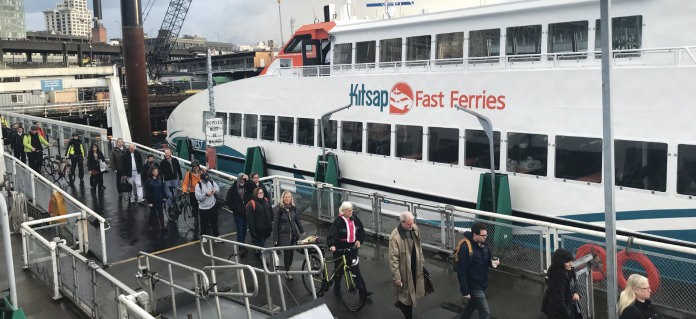The Puget Sound Regional Council (PSRC) has released their 2017 travel survey data and it contains some really interesting nuggets. Households were asked a variety of questions about how they get to work, whether or not they pay for parking, and if they have access to or use subsidized transit passes. The data is also broken into demographic categories, such as race and income. Using story charts with this information, the PSRC is able to draw out key patterns. Dataminers, however, could go much more granular for other patterns and findings.
Paying for parking and transit

A key finding in the PSRC’s data is that most workers in the region have access to free parking at work. A full 82% of workers reported that their parking was free with another 8% indicating that their employer either pays part or all of the costs of parking passes. Lower-income workers indicated that were more often paying for their parking than higher-income workers who received subsidies from their employees. The PSRC also noted that when employers or worksites charge for parking, the scales tip very heavily for workers across the board to take transit or other active transportation modes.

Employer-subsidized transit passes appear to be going to higher-income individuals. This tends to make sense with how the state’s Commute Trip Reduction (CTR) program works. Larger employers–which tend to be higher paying–are required to create a CTR program for employees. These programs often include subsidized or free transit passes. However, that often leaves lower-income individuals without cheaper transit options unless they qualify for ORCA LIFT, a reduced fare program that King County launched in 2015.
Accessing transit by other modes

Across the region, there is a lot of political and community discussions about the need to build parking to support transit access. The conventional wisdom there is that not many people will use transit without parking at transit centers. It turns out though that theory may be false. The PSRC reports that less than 10% of people actually drove and parked to use transit. More than 80% walked to reach their bus or train. Another 4% got dropped off. Interestingly, riding a bike to connect with transit was less than 1%, which likely is representative of the low capacity that buses and trains have for carrying bikes, lack of sufficient infrastructure to store bikes at key locations, and unsafe or non-existent facilities to reach transit on bike.
Mode choice by race and income

Income plays a strong role in how people choose their modes. Lower-income households gravitated heavily toward transit and walking while reporting substantially lower shared driving trips. Higher-income households report lower drive-alone rates and shared driving trips than other income ranges. These mode choices make some sense since lower-income households work lower paying jobs, often at odd hours. Sharing trips with others is a challenge and the cost of owning a car can be substantial. Wealthier households often are able to be more flexible in their trips and modes.

Meanwhile, the racial breakdown varied significantly by mode. Asians had the highest drive-alone and biking rates while reporting lower shared driving trips. Black, Latino, and other multiracial households reported double the transit rate, substantially lower drive-alone rates, and higher shared driving trips. Caucasian households had the lowest transit use rates, but otherwise were middle of the pack for other modes.
Mode choice and housing

The PSRC has several Regional Growth Centers (RGCs) designated for higher density and mixed-use development. RGCs in Seattle reported the highest rates of walking, transit, and bike use amongst households living in them–more than double other geographies in some cases. RGCs generally had higher walking and transit trips by households. Surprisingly, households in RGCs outside of Seattle reported higher drive-alone rates than households not living in RGCs altogether. Shared driving trips were most often made by households living outside of RGCs.

Lower-income households most often reported that living in a walkable neighborhood and nearby activities was of high importance to them. This was increasingly less important to middle-income and higher-income households. It seems very likely that this is related to regular access to a car, which very low-income households generally lack. Walkability and nearby services clearly would become more important as part of one’s daily life. Higher-income households, on the other hand, have more money to spend on other aspects of life, which may affect their locational priorities.

Finally, the PSRC data on the importance on proximity to transit and income generally mimics the previous dataset. Lower-income households deeply value transit access with over 60% reporting it as important, which likely reflects a clear need for affordable mobility. Almost 50% of middle-income and higher-income households reported transit access as important even though those households generally have more mobility options. That data point likely is a testament to how most people value transit service in general across the region regardless if they use it or not on a regular basis.
Stephen is a professional urban planner in Puget Sound with a passion for sustainable, livable, and diverse cities. He is especially interested in how policies, regulations, and programs can promote positive outcomes for communities. With stints in great cities like Bellingham and Cork, Stephen currently lives in Seattle. He primarily covers land use and transportation issues and has been with The Urbanist since 2014.



